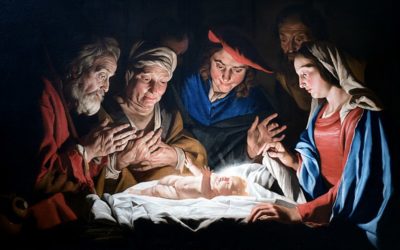In September 1830, just five months after the Church of Christ was organized, Church members were studying the Bible, Book of Mormon, and manuscript copies of Joseph Smith’s revelations, when they had access to them. Isaiah 52:8 and related passages in the Book of Mormon (Mosiah 12:22, 15:29, 3 Nephi 16:18) prophesied that “they shall see eye to eye, when the Lord shall bring again Zion.” In the Book of Mormon, the resurrected Christ also told the people in the Americas that they were the children of Israel, that God would establish them in that land, and that He would dwell with them. They would then “see eye to eye,” and the Father would “gather them together again, and give unto them Jerusalem for the land of their inheritance”—a “New Jerusalem” (3 Nephi 20).
Establishing this New Jerusalem became a topic of serious interest to members of the new Church, as did the fall of Adam and the plan of salvation. In introducing the revelation that is now section 29 of the Doctrine and Covenants, John Whitmer recorded, “A Revelation to Six Elders of the Church & three members they understood from Holy Writ that the time had come <that> the People of God should see eye to eye & they seeing somewhat different upon the death of Adam (that is his transgression) therefor they made it a subject of Prayer & enquired of the Lord & thus came the word of the Lord through Joseph the seer.”
For further information on the background of this section, click here.
The Gathering and Missionary Work
Section 29 reinforced the concept of gathering mentioned repeatedly in the Book of Mormon. In verses 1 and 2, the Lord said he would “gather his people even as a hen gathereth her chickens under her wings” if they lived worthily. In verse 3, He forgave them for their sins, provided they remembered “to sin no more.” Then He told them they were “chosen out of the world to declare my gospel with the sound of rejoicing.”
This was not only a call for Church members to gather but also a commandment for them to preach the gospel that others might do the same. Verse 7 explained, “ye are called to bring to pass the gathering of mine elect; for mine elect hear my voice and harden not their hearts.”
“Wherefore,” the Lord declared in verse 8, “the decree hath gone forth from the Father that they shall be gathered in unto one place upon the face of this land, to prepare their hearts and be prepared in all things against the day when tribulation and desolation are sent forth upon the wicked.”
The idea of gathering “unto one place” was an important emphasis of the Church in the nineteenth century. Joseph Smith later said that the main purpose of gathering “the people of God in any age of the world . . . was to build unto the Lord an house whereby he could reveal unto his people the ordinances of his house.”
Section 28 of the Doctrine and Covenants, which was received after section 29, corrected Hiram Page’s false revelations about the new gathering place in Zion, or the New Jerusalem. “And now, behold,” section 28, verse 9 declared, “I say unto you that it is not revealed, and no man knoweth where the city Zion shall be built, but it shall be given hereafter. Behold, I say unto you that it shall be on the borders by the Lamanites.”
This made the mission to which Oliver Cowdery was called in section 28 all the more exciting since he was to “go unto the Lamanites and preach my gospel unto them” (verse 8).
The Second Coming and the Millennium
Section 29 told Church members they were to gather in anticipation of the Lord’s Second Coming and His thousand-year reign known as the Millennium. “For the hour is nigh and the day soon at hand,” verse 9 explained, “when the earth is ripe; and all the proud and they that do wickedly shall be as stubble; and I will burn them up, saith the Lord of Hosts, that wickedness shall not be upon the earth.”
On His coming, he said, “I will reveal myself from heaven with power and great glory, with all the hosts thereof, and dwell in righteousness with men on earth a thousand years, and the wicked shall not stand.”
These declarations made the members of the new Church all the more eager to gather together, build the New Jerusalem, and preach the gospel to others, that they too might be saved from the impending destruction.
Initial Judgment and Resurrection
Section 18, verse 37, had charged the Three Witnesses with selecting twelve apostles for the new Church. The Quorum of the Twelve would not be formed until 1835. Meanwhile, in section 29, the Lord explained that His twelve apostles “which were with me in my ministry at Jerusalem, shall stand at my right hand at the day of my coming in a pillar of fire, being clothed with robes of righteousness, with crowns upon their heads, in glory even as I am.” They would be responsible “to judge the whole house of Israel, even as many as have loved me and kept my commandments, and none else.” (verse 12)
Simultaneously with the Lord’s coming would be a resurrection of the righteous. “For a trump shall sound both long and loud, even as upon Mount Sinai, and all the earth shall quake, and they shall come forth—yea, even the dead which died in me, to receive a crown of righteousness, and to be clothed upon, even as I am, to be with me, that we may be one” (verse 13).
Signs of the Second Coming
Section 29 also explained some of the signs preceding the Second Coming. These signs included the following:
- “the sun shall be darkened” (verse 14)
- “the moon shall be turned into blood” (verse 14)
- “the stars shall fall from heaven” (verse 14)
- “and there shall be greater signs in heaven above and in the earth beneath” (verse 14)
- “there shall be weeping and wailing among the hosts of men” (verse 15)
- “there shall be a great hailstorm sent forth to destroy the crops of the earth” (verse 16)
- the Lord would “take vengeance” on the unrepentant wicked (verse 17)
- flies would “take hold” of the earth’s inhabitants, “eat their flesh,” and “cause maggots to come in upon them” (verse 18)
- “their tongues shall be stayed that they shall not utter against” the coming Lord (verse 19)
- “their flesh shall fall from off their bones” (verse 19)
- “their eyes” shall fall “from their sockets” (verse 19)
- “the beasts of the forest and the fowls of the air shall devour them” (verse 20)
- “the great and abominable church . . . shall be cast down by devouring fire” (verse 21)
These signs made members of the Church all the more eager to gather to Zion, preach the gospel so others could avoid the prophesied destruction, and build the New Jerusalem in anticipation of the Lord’s coming.
After the Millennium
Section 29 told members of the new Church what would happen after the Millennium. The Lord explained “that when the thousand years are ended, and men again begin to deny their God, then will I spare the earth but for a little season” (verse 22).
When that short season ended, “the heaven and the earth shall be consumed and pass away, and there shall be a new heaven and a new earth” (verse 23).
With the new heaven and earth would come a renewal of life, including “both men and beasts, the fowls of the air, and the fishes of the sea” (verse 24).
Before the earth was renewed, Michael the archangel “shall sound his trump,” signaling the final resurrection (verse 26). The Lord would then reward the righteous with “eternal life” and the wicked with “everlasting fire, prepared for the devil and his angels” (verses 28‒29).
Hints of Salvation for the Dead
To the new Church members, who were virtually all converts from a Protestant culture, the division of the righteous from the wicked sounded like the traditional distinction that had developed among Christians of a simple heaven and hell. But section 29 gave hints of more to come about the salvation of the dead.
Of those assigned to “everlasting fire,” the Lord explains, “never at any time have I declared from mine own mouth that they should return, for where I am they cannot come, for they have no power” (verse 29). In other words, on their own, they could never rise from where they are in the spirit world to where Christ dwells.
“But remember,” the Lord adds, “that all my judgments are not given unto men; and as the words have gone forth out of my mouth even so shall they be fulfilled, that the first shall be last, and that the last shall be first in all things whatsoever I have created by the word of my power, which is the power of my Spirit” (verse 31).
Unity of the Spiritual and Temporal
Someone in the group whose inquiries led to this revelation had asked about the distinction between spiritual and temporal things. Over the centuries preceding the Restoration, a philosophical distinction had developed between the spiritual and temporal, with the spiritual being ruled by God and the temporal by governments. In section 29, the Lord taught that He had created “all things both spiritual and temporal” (verses 31).
In explaining this concept, the Lord referred to “the beginning of my work” and “the last of my work” (verse 32). Several weeks earlier, during the early months of Joseph Smith’s translation of the Bible, the Lord had given him a revelation that is now Moses 1 in the Pearl of Great Price, revealing that “worlds without number have I created” (Moses 1:33) and that His works really have no beginning or end. In section 29, He echoed this revelation, explaining, “my works have no end, neither beginning; but it is given unto you that ye may understand, because ye have asked it of me and are agreed” (verse 33).
The Lord then explained that because He created all things spiritual and temporal, they really couldn’t divide them up the way people had tended to do. “All things unto me are spiritual,” He said, “and not at any time have I given unto you a law which was temporal; neither any man, nor the children of men; neither Adam, your father, whom I created” (verse34). He gave Adam agency, or the freedom to choose right from wrong, “but no temporal commandment gave I unto him, for my commandments are spiritual; they are not natural nor temporal, neither carnal nor sensual” (verse 35).
This would subsequently become important as Church members were asked to sacrifice their temporal resources for the spiritual work of the Lord’s kingdom.
The Premortal Life
Besides addressing the Second Coming and Millennium, as well as the rewards in the next life, section 29 also addressed the premortal life. In premortality, “the devil . . . rebelled against me, saying, Give me thine honor, which is my power” (verse 36). In this rebellion, the Lord recounted, Satan turned “a third part of the hosts of heaven , . . away from me because of their agency,” as a result of which “they were thrust down, and thus came the devil and his angels” (verses 36‒37).
The Lord also made two other points. First, “there is a place prepared for them from the beginning, which place is hell” (verse 38). Second, “it must needs be that the devil should tempt the children of men, or they could not be agents unto themselves; for if they never should have bitter they could not know the sweet” (verse 39).
The Fall and Atonement
From the premortal life and war in heaven, section 29 went on to address the fall of Adam and the atonement. The Lord explained that by partaking of the forbidden fruit, Adam was cast out of the Garden of Eden and became spiritually dead, meaning separated from the presence of God. This “first death” would also become the “last death” when the wicked are cast out from the Lord’s presence. (Verses 40‒41.)
But God provided a way through His Only Begotten Son for people to exercise faith in the Savior’s name, repent, and be redeemed that from “his natural death he might be raised in immortality unto eternal life” (verses 42‒43). By not repenting, the wicked make their own choice and “receive their wages of whom they list to obey” (verses 44‒45).
Salvation of Little Children
Although the explanation of the fall and atonement seemed consistent with Christian teachings at the time, section 29 echoed Moroni 8 in the Book of Mormon by addressing the salvation of little children and those who do not hear the gospel message in mortality.
Regarding little children, it explains that they “are redeemed from the foundation of the world” through the Savior and “cannot sin, for power is not given unto Satan to tempt little children, until they begin to become accountable before me” (verses 46‒47).
Moroni 8:22 also explains that those “who have no law” are “not condemned,” and verses 49 and 50 of section 29 deal briefly with this group, ending with, “And now I declare no more unto you at this time,” suggesting that the Lord might reveal more later.
So it was that by September 1830, when the revelation that is now section 29 was received, the Lord had blessed his new Church with remarkable insights into His plan for the exaltation and eternal life of His children.
(Photo credit: Detail from George Edward Anderson photo of the grave marker of Joseph and Emma Smith’s first baby, cemetery at Harmony, Pennsylvania, public domain, copied from https://contentdm.lib.byu.edu/digital/collection/RelEd/id/5322/ [accessed March 20, 2021].)



